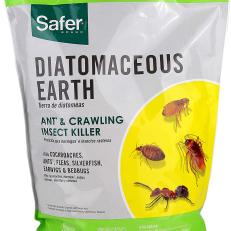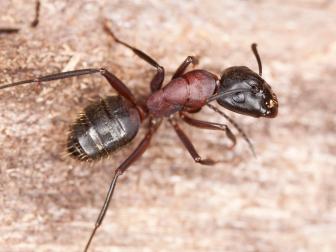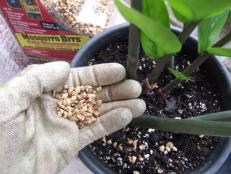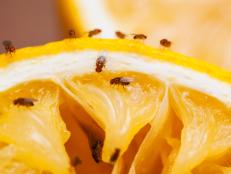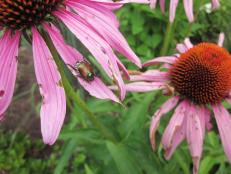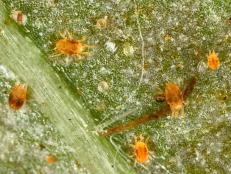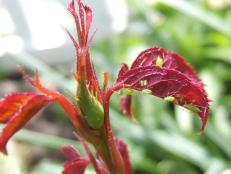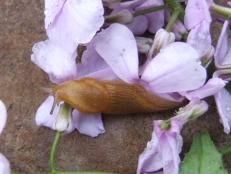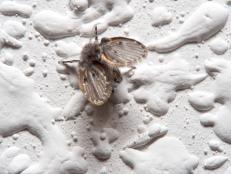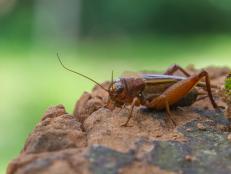How to Get Rid of Ants Indoors and Outdoors
Find out what to do when ants cause a problem in your house or outdoors, including natural remedies for ridding your space of these small but mighty pests.
Ants are one houseguest you can live without. Indoors, ants are invaders, getting into your stuff and causing chaos. Outdoors, they can turn family lawn games or gardening into painful experiences when you accidentally disturb their nest.

Shutterstock/Michaella Jackson
The part of the anthill you see is just the tip of the ant colony iceberg. Colonies often extend 2' to 3' beneath the surface mound and another 2' to 4' around it.
Just because ants are little doesn't mean they're a pushover when it comes to removal. Ants roamed the earth with dinosaurs like Tyrannosaurus rex — and survived a mass extinction event. That means ants have some serious staying power. But it is possible to get rid of ants as long as you don't underestimate them.
Why Do Ants Come Inside the House?
There are many reasons ants will invade your home. They could be looking for food or water, or if there is rotting wood in your home, the ants may use it for habitat. Late spring and early summer are the most common times ants enter a home because that’s when they’re most active.
Whether you're dealing with ants indoors or out, it's best to eliminate the ant nest versus simply repelling ants. Each ant colony can contain hundreds or thousands of members. Left alone, ant colonies multiply, and a small problem can become a nightmare pretty quickly.
Understand How Ants Live
Outdoors, it's easy to spot an anthill in the lawn or on the pavement. The part of the anthill you see is just the tip of the ant colony iceberg. Colonies often extend 2 to 3 feet beneath the surface mound and another 2 to 4 feet around it. Indoors, it's not easy to spot the nest, because ants tend to hide — beneath floors, in walls or between cabinets.
Each ant colony includes at least one queen and worker ants. The colony survives as long as the queen lives. Whatever tactic you embrace to get rid of ants, aim to kill the queen. If your treatment fails and the queen lives, the colony can splinter and migrate, forming new colonies. If you only repel ants, they may exit one area, but will likely turn up somewhere else.
Indoors or out, ant baits provide the most effective control. A bait is a blend of a slow-acting pesticide (natural or chemical) and sweet or salty ant food. The food disguises the pesticide, so ants eat it and carry it back to their nest, feeding it to baby ants and the queen. When using ant baits, you typically see more ants at first, as they discover and visit the bait. During this time, resist the urge to use ant killing-sprays or repellents. You want the ants to carry the bait back to the nest so the colony is eliminated.
How to Get Rid of Ants in Your House
If you see a few ants in your home, it's a safe bet that there are actually many more present. Of the 25 ant types that typically invade homes, house ants are the most common. They’re usually less than 1/8 of an inch long and are really just a nuisance pest, not causing damage or carrying diseases.
Techniques for Getting Rid of Ants in Your House
- Seal all doors and windows, and cracks in your home’s foundation. Ants and other insects can crawl through the tiniest crevices.
- Keep your kitchen spotless. Wipe countertops and other surfaces with a citrus-scented spray – citrus repels ants.
- Vacuum the kitchen floor frequently and be sure to properly seal and store all food in airtight containers.
- Don’t leave pet food sitting out longer than necessary.
- Mix equal parts baking soda and powdered sugar and place in a small lid or shallow container in the area where you're seeing ants. When ants nibble baking soda, it reacts with an acidic material in their stomachs and kills them. This bait can help kill ants in the nest.
- Make a colony-killing bait by blending equal parts Borax and corn syrup. Smear on a small piece of cardboard or index card. Ants love corn syrup, and when they eat it, the Borax kills them.
- Sprinkle food-grade Diatomaceous earth (DE) along ant trails. DE kills ants through dehydration. It affects only those ants that come into contact with it and has no effect on ants in the nest.
- Place commercial bait gels in areas where ants are crawling. Most indoor ants like sweet food, which is commonly found in gel ant baits. Squeeze gel into cracks or place a pea-size amount onto a piece of masking tape (sticky side down) to keep gel off surfaces. If you have children or pets, use gel only in areas they can't reach. Fully enclosed plastic bait stations are a good choice for use around pets and kids, although some pups may try to chew them.
- Make a spray of 1/4-cup Castile liquid soap and 1 quart of water. This spray kills ants on contact. It's effective against scout ants but won’t kill ants back in the nest.
Shop Indoor Ant Solutions
Easy Ways to Repel Ants
To lower the chances of ants wandering indoors, follow these easy tips.
- Make a barrier. Place a substance that ants dislike along door thresholds, window ledges, baseboards — anywhere ants might enter your home. Ants dislike cinnamon, cayenne pepper, ground chalk and cornmeal.
- Spritz vinegar. Fill a spray bottle with equal amounts common white vinegar and water. Spray where ants enter your home.
- Peel citrus. Save and dry citrus peels (lemon, lime, grapefruit, oranges, etc.). Place dried peels in a food processor or grinder and pulse them into powder. Sprinkle powdered peels in areas where ants enter the home.
- Use oils. Essential oils including peppermint, tea tree and citrus types repel ants. Blend 1/4 cup of water with 7 drops of citrus oil or 15 drops of tea tree or peppermint oils. Shake well and spray along baseboards, windowsills or other places ants enter your home. Or place a few drops of orange, lemon or peppermint oil on cotton balls and tuck into cabinets or pantry areas to keep ants out.
Shop Outdoor Ant Solutions
How to Get Rid of Outdoor Ants
The big difference in controlling outdoor ants is that you can often see the nest and deal with it directly. Try some of these methods to get rid of ants outdoors.
- Boiling water. Rake open the nest and pour in boiling water (add liquid soap for extra killing power). Boiling water does kill vegetation, so be careful using this method on lawns.
- Vinegar. Mix equal parts vinegar and water. Add a few drops of liquid soap to increase killing power. Rake open the ant nest and pour in the mixture. Vinegar can kill vegetation, so use care when applying to lawns.
- Water. Soak the nest for 15 to 30 minutes with water from a hose, saturating soil. Ants can survive underwater for about 24 hours, so you may need to repeat the treatment approximately 22 to 23 hours later to ensure ants truly drown.
- Boric acid. Make your own liquid ant bait by blending 3 tablespoons sugar or peanut butter with 2 tablespoons boric acid crystals and 2 cups of water. Boil for 6 minutes to dissolve acid crystals. Cool and store in a labeled jar. Create a bait container using a yogurt cup or other container. Punch holes in it so ants can crawl in and out. Put 2 to 3 tablespoons of the solution into the bait container and cover with a lid or foil. Place the container near the ant nest.
- Chemical ant killers. Open the top of the ant mound and apply an ant-killer pesticide (granules, dust/powder or liquid form), following label instructions. Some treatments work like bait and kill ants slowly, as they carry it back into the nest. Other chemicals kill ants on contact, which means you may not get the queen. In this case, the nest may eventually disappear, but a smaller nest may develop nearby. Treat this second nest and monitor the area for further ant activity.
Types of Ants
Large black ants (1/4 to 1/2 inch long) are likely carpenter ants, which nest in wood and can seriously damage your home. If you're seeing carpenter ants indoors on a regular basis, call a pest control expert. One or two carpenter ants indoors signal that they're living near your home and have found a way in. The nest could be in a deck, a tree trunk, a woodpile, a damp soffit or an outside wall under a leaky faucet.
What to Do About Carpenter Ants
Carpenter Ants
The insect you'll want to see pack up its tool belt and scram.
Carpenter ants attack softwood (rotten or damp). Nest clues include sawdust at the base of a tree, porch or deck. If you don't see active ant trails that you can follow to a nest in daylight, use a flashlight or headlamp to scout at night when these ants are very active. Carpenter ants can literally destroy your home in ways similar to termites, so it's best to get professional help.
Organic Pest Control: Fact and Fiction 24 Photos
Do grits kill fire ants? Will dryer sheets repel mosquitoes? Find out which DIY tricks really work when it comes to banishing pests.









